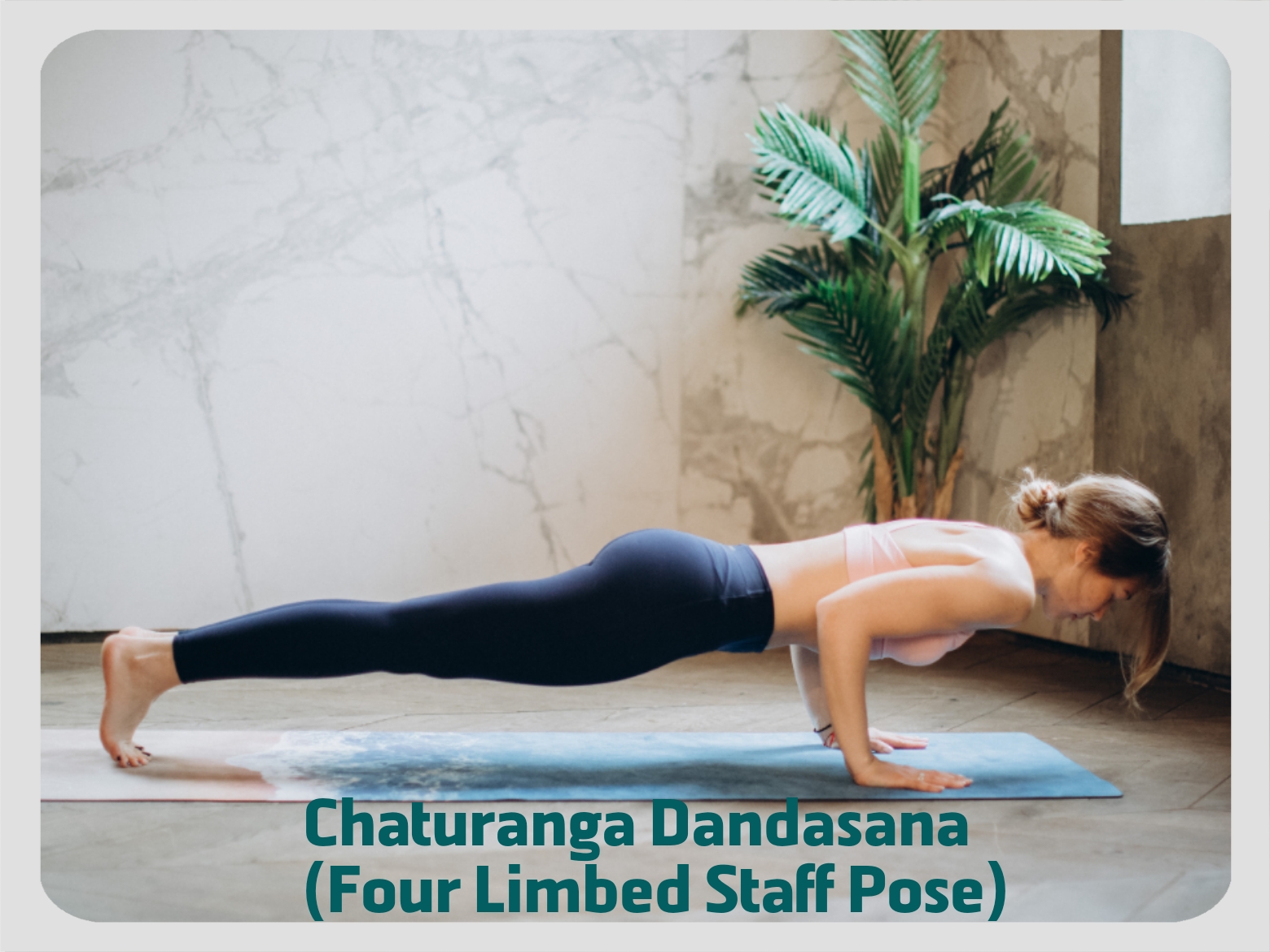Chaturanga Dandasana
Chaturanga Dandasana is also known as “Four-Limbed Staff Pose”.
The term “Chaturang” suggests that the body is supposed to be capable of four limbs while performing this asana, which includes two arms and two legs. You need patience and steadiness to perform this asana, which signifies physical and mental steadiness.

How to do Chaturanga dandasana
1. First lie flat on the yoga mat or a mat. Brace your abdomen so that the spine complex shoulders, back and legs are straight.
2. Keep your hands straight along the body and keep your soles on the ground. Don’t spread your hands to the sides.
3. Now in the starting position of the configuration, raise your body into a row position. Raise the weight of your feet and hands evenly so that your body forms a straight line.
4. Now lower your shoulders and slowly move your hands in front of your chest. Don’t let your shoulders drop down.
5. Pull your stomach in and keep your back strong.
6. Keep in mind that your navel should go straight up and your body should maintain a flat line.
7. Try not to raise your neck high and keep your head in a flat line.
8. Stay in this position for some time and take breaths slowly and leave them.
With meditation and regular practice, you can do Chaturanga Dandasana correctly and reap its benefits.
Benefits of Chaturanga Dandasana
Chaturanga Dandasana is a yoga practice that has many benefits. This exercise strengthens various parts of the body and helps in reducing mental worries. Below are some Chaturanga Dandasana benefits:
1. Strengthens core and arms
Chaturanga Dandasana helps strengthen the abdominal, lumbar, and back muscles, which improves body balance.
2. Reduces stress and anxiety
This asana helps in reducing mental stress and aids in calming meditation.
3. Increases body flexibility
Chaturanga Dandasana increases the flexibility of the body, which makes it easier to perform other body exercises.
4. Benefits the heart and lungs
This posture is suitable for the heart and helps in keeping the lungs healthy.
5. Promotes overall balanced development
This asana helps in developing all the parts of the body in a balanced manner.
Precaution of Chaturanga Dandasana
Regular practice of Chaturanga Dandasana develops a sense of patience and steadiness. It is important to take care of the following precautions while doing Chaturanga Dandasana:
1. People with weak bones should especially consult a doctor before doing this asana.
2. Pregnant women should not do this asana.
3. If there is pain in the back or back, then consult a doctor before doing this asana.
4. While doing this asana, keep breathing normal, do not try to inflate for a long time.
5. Avoid over straining the shoulders and hands, seek help before or while lifting all heavy things.
6. Keep the back, knees and ankles straight until the ability to perform the asana correctly.
7. Do this asana according to the strength of the body, do not exert too much effort which may lead to injury and stress.
Frequenty Asked Qustions
To do Chaturanga Dandasana, first of all sit on a yogamat or mat. Keep the hands at a distance from the body, then taking a deep breath, lower the body and make the bones the base. Keep the height of the feet also controlled so that the body maintains a straight line.
Pregnant women, people with rocky bones, people having back or waist pain should consult a doctor before doing Chaturanga Dandasana.
Performing Chaturanga Dandasana strengthens the core, benefits the heart and circulatory system, develops inner strength, and improves balance.
While doing Chaturanga Dandasana, breathing should be normal, shoulders and hands should be avoided, and the body should be taken care not to work excessively.
To do Chaturanga Dandasana properly, keep the shoulders, wrists, palms, and feet on a straight line. The neck should also be kept aligned while correcting the body. Keep in mind that observation and balance of the body should be maintained so that this asana can be beneficial. How to do Chaturanga Dandasana?
Who should not do Chaturanga Dandasana?
What are the benefits of Chaturanga Dandasana?
What are the precautions while doing Chaturanga Dandasana?
How to do Chaturanga Dandasana correctly?
Read Also
- How to do Surya Namaskar (Sun Salutation)? Benefits & Steps
- Poorvottanasana (Upward Plank Pose)- How to Do it And Benefits
- Benefits of Muktasana (Sukhasana): How to Do it?
- Bhadrasana (Gracious Pose)-Steps, Benefits & How to Do it
- Bhadrasana (Gracious Pose)-Steps, Benefits & How to Do it
- Konasana- Benefits And How to Do It?